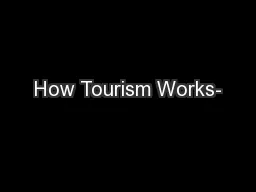

Short Version What do we need to know Tourism is a service industry The business of tourism uses attractions that are already present Touring Alcatraz Island Unlike most other economic activities that enjoy virtual exclusive rights over the use of their resource base tourism resources are ty ID: 333741
Download Presentation The PPT/PDF document "How Tourism Works-" is the property of its rightful owner. Permission is granted to download and print the materials on this web site for personal, non-commercial use only, and to display it on your personal computer provided you do not modify the materials and that you retain all copyright notices contained in the materials. By downloading content from our website, you accept the terms of this agreement.
Slide1
How Tourism Works-
Short VersionSlide2
What do we need to know?Slide3
Tourism is a service industry
The business of tourism uses attractions that are already present
Touring Alcatraz Island
Unlike most other economic activities that enjoy virtual exclusive rights over the use of their resource base, tourism resources are typically part of the public domain or are intrinsically linked to the social fabric of the host community.Slide4
Tourists expectations
Tourism activities can be invasive, especially when the perception exists that they have been imposed on the host community
The
tourismification
of cultural heritage assets presents a number of issues for the management of these assets, not the least of which is the challenging task of accommodating both the needs of the tourism industry and the ideals of cultural heritage management Slide5
Tourism Is
Entertainment
To be successful and therefore commercially viable, the tourism product must be manipulated and packaged in such a way that it can be consumed easily by the
public.
The reason is that only a small number of tourists really seek a deep learning experience when they travel
.
The
rest are traveling for pleasure or escapist reasons and wish to participate in activities that will provide a sense of enjoyment. Some people explain this phenomenon by arguing that tourists accept entertainment or
commodified
experiences as being a manifestation of the modern consumerist lifestyle; tourism becomes an end in itself and not a means to some loftier goal.Slide6
Tourism is fundamentally a demand-driven activity
Tourism is
influenced more by market forces (tourists and the industry that seeks to satisfy tourists' needs), rather than by governments that try to control or manage it.
The
ability to control tourism must be predicated on the
assumption
of being able to control tourists.
Proponents
of a chaos theory
illustrate
that tourism markets are dynamic, erratic, nonlinear, and are noted for their great volatility. Slide7
Tourism is driven by attractions
Marketing calls attractions--demand
generators.
Not all
tourism attractions have equal demand-generation potential.
A
clear hierarchy of tourist attractions exists that can be defined according to the degree of compulsion felt by tourists to visit.
The
more dominant the attraction is, the greater the sense of obligation to
visit
However, the
purchase decision becomes increasingly discretionary for lower-order attractions, until visits to the lowest-order ones are typified by low involvement decisions involving little effort required on behalf of the visitor.Slide8
Not All Cultural Assets Are Cultural Tourist
Attractions
Not
all cultural assets have tourism potential.
Cultural
heritage places are usually designated
as significant by
communities
for
reasons other than their tourism
potential.
The basic rule of thumb is that attractions that are located close to large population or tourist centers will attract significantly larger numbers of visitors than more distant attractions.
The
same maxim holds true on a micro or destination-specific scale. Readily accessible attractions will enjoy greater visitation levels than out-of-the-way assets, unless the compulsion to visit them is so great that remoteness becomes a nonissue.